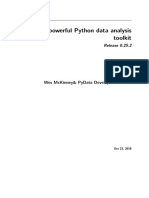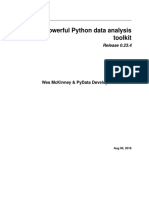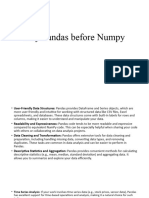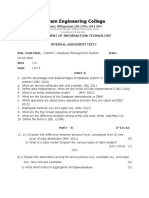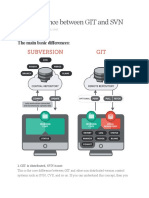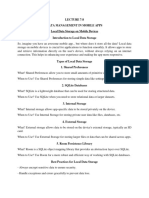pandas:
Software library for data manipulation and analysis in Python
The pandas library in Python is a powerful and open-source tool for data
manipulation and analysis. It is built on top of the NumPy library and provides
data structures and functions to perform efficient operations on data.
Here are some key points about pandas:
Name Origin: The name "pandas" is derived from "panel data," which refers to a type
of data that is structured in a tabular format, similar to a spreadsheet or SQL
table.
Purpose: Pandas is designed for data analysis and manipulation, making it an
essential tool for data analysts, scientists, and engineers working with structured
data in Python.
Data Structures
Series: A one-dimensional labeled array capable of holding data of any type
(integer, string, float, etc.). Each value in the series has a label, and these
labels are collectively referred to as an index.
DataFrame: A two-dimensional data structure with labeled axes (rows and columns).
It is a tabular structure that can be used to store and manipulate data.
Key Features:
Data Cleaning and Manipulation: Pandas provides various methods for cleaning and
manipulating data, including handling missing data, merging and joining data, and
inserting and deleting columns.
Time Series Analysis: Pandas supports time series analysis and provides functions
for handling dates and times.
Data Visualization: Pandas integrates well with data visualization libraries like
Matplotlib, making it easy to create plots and charts.
Split-Apply-Combine: Pandas provides the groupby() function, which allows for
split-apply-combine operations on data sets.
Installation and Usage
Installation: Pandas can be installed using pip, the Python package manager.
Importing: The library is typically imported as pandas or pd for convenience.
Community and Resources
Documentation: The official pandas documentation provides detailed information on
its features and usage.
Tutorials: Various tutorials and guides are available to help users get started
with pandas, including interactive tutorials and video series.
Advantages
Efficient Data Processing: Pandas is built on top of NumPy and provides high-
performance data manipulation capabilities.
Easy Data Analysis: Pandas simplifies data analysis tasks, making it a popular
choice among data analysts and scientists.
Conclusion
Pandas is a powerful and versatile library that simplifies data manipulation and
analysis in Python. Its data structures and functions make it an essential tool for
data analysis and manipulation tasks.
The installation process for pandas involves several steps and methods depending on
the operating system and the user's familiarity with command-line interfaces. Here
are the detailed steps for installing pandas on different platforms:
Windows:
Method 1: Using pip
Step 1: Launch Command Prompt
Open the Start menu and search for "Command Prompt" or use the Windows key + R to
open the "RUN" box and type "cmd" to open the Command Prompt.
Step 2: Enter the command
In the Command Prompt, type pip install pandas and press Enter to start the
installation process.
�Method 2: Using Anaconda
Step 1: Download Anaconda
Go to the Anaconda download page and download the installer for Windows.
Step 2: Install Anaconda
Run the installer and follow the prompts to install Anaconda. This will also
install pandas and other necessary packages.
Linux:
Method 1: Using pip
Step 1: Install pip
Run the command sudo apt-get install python3-pip to install pip3 on Ubuntu-based
systems.
Step 2: Install pandas
Run the command pip3 install pandas to install pandas.
Method 2: Using Anaconda
Step 1: Install Anaconda
Download the Anaconda installer from the Anaconda website and follow the prompts to
install Anaconda.
Step 2: Install pandas
Anaconda will automatically install pandas and other necessary packages during the
installation process.
Mac OS:
Method 1: Using pip
Step 1: Install pip
Run the command sudo pip3 install pandas to install pandas using pip3.
Method 2: Using Anaconda
Step 1: Install Anaconda
Download the Anaconda installer from the Anaconda website and follow the prompts to
install Anaconda.
Step 2: Install pandas
Anaconda will automatically install pandas and other necessary packages during the
installation process.
Additional Tips
Using Virtual Environments
It is recommended to install pandas in a virtual environment to avoid conflicts
with other packages and to ensure a clean installation. This can be done using
tools like conda or virtualenv.
Checking the Version:
After installation, you can check the version of pandas using import pandas as pd;
print(pd.__version__).





















